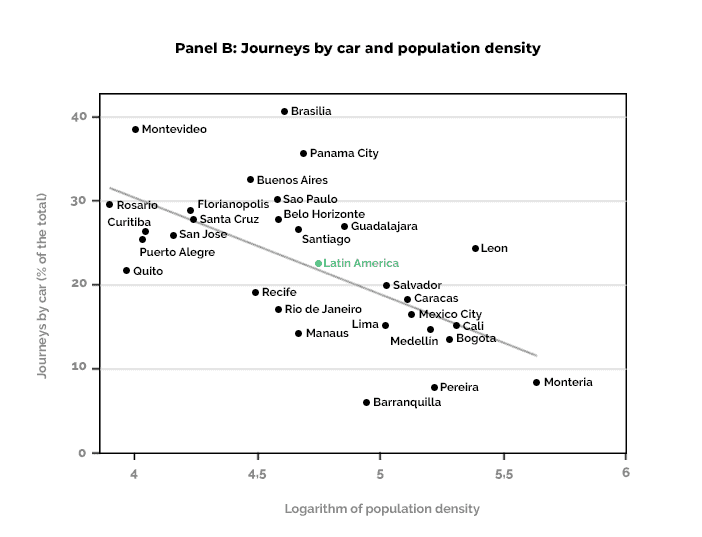Written by: José Rodríguez of Polymath Ventures
Contxto – A report elaborated by the Development Bank of Latin America (CAF) in 2018 shows the direct relationship between GDP per capita and the percentage of journeys taken by private cars. As expected, when income rises individuals feel more inclined to find more comfortable ways to move, and private vehicles have historically offered exactly that.

However, there is also an inverse relationship between population density and private car ownership as shown by the graph below, also published by CAF. Research shows that this relationship is mainly attributed to the economies of scale that public transport and collaborative economies can achieve in high-density population areas. Latin America is amongst the most urbanized regions in the world, with 80 percent of the population living in large cities. It is expected that by 2025, 90 percent of the population will be urbanized, and with that, the population density will magnify.

Additionally, urban mobility is expensive in the region. On average, Latin Americans spend around 19 percent of their monthly income on transportation, whereas in the U.S. that number goes down to 13 percent and it’s expected to be 14 percent in China next year. Besides, more than 20 percent of Latin Americans don’t have access to public transport located less than 10 minutes away from their place of residence. In informal residential areas, this distance increases significantly.
These circumstances create an opportunity to take advantage of the highly fragmented and under- optimized mobility sector, and global ride-hailing giants like Uber and Didi Chuxing have taken notice. Latin America is already one of Uber’s most important markets, with Mexico being its third largest market worldwide.
The entry to Latin America of global new mobility giants has created an interesting opportunity for local startups. Latin America has unique market dynamics which local startups understand and are now partnering with global mobility players to help them adapt. In the ride-hailing segment, for example, vehicle supply is a huge issue because of the low rates of car ownership in the region and restricted access to financing for potential drivers. Didi and Uber are partnering with Latin American startups who understand local dynamics, such as Kovi and Taximo, to help solve the vehicle supply issue.
Additionally, global tech companies have learned that they can maximize the probability of finding the right product-market-fit by associating themselves with local players that are familiar with the market and its operational and cultural characteristics.
Today, Didi Chuxing can use its Didi Cloud Platform and AI capabilities to optimize dispatch systems, plan routes and predict traffic hot spots in order to guarantee optimal supply and leverage learnings about transportation usage and behavior that local players like Taximo, ClickBus or Kovi have acquired throughout the years – to ultimately create more mobility options for the population in record times.
In China, Didi Chuxing started as a platform that allowed users to hail a taxi from their phones and pay for the service using an online payment method. The company continued to develop alternative mobility options that could also become a one-stop shop for the different mobility needs of a single consumer – from minibus bookings to car rentals. This approach has not been tested yet in Latin America, but we believe there is a huge opportunity thanks to the fragmented nature of mobility in the region.

Other micro-mobility companies like Mobike or Grin are also improving mobility options in Latin America and offsetting its poor infrastructure. These companies are leveraging access to smartphones in the region and an increasing population density to create alternative ways to quickly get from point A to B. These options are big contributors in reducing congestion and pollution levels.
Better urban mobility improves the quality of life of the citizens of these cities by improving the quantity and quality of reachable job opportunities for individuals, facilitating the dissemination of ideas between areas that did not previously have a physical connection and creating savings for consumers. Higher accessibility results in a more dynamic economic environment and more importantly, a better lifestyle.
We are seeing users leapfrog private vehicle ownership, preferring to use new mobility solutions, especially in highly dense and urbanized areas where driving a car usually does more harm than good.
In future articles, we will explore the extent to which partnerships between local and international ride- sharing players can create new efficiencies in emerging markets and propel economic development in Latin America.






